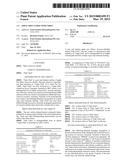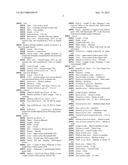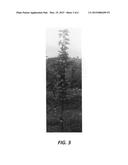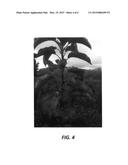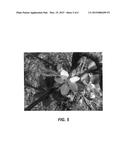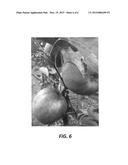Patent application title: Apple tree named 'Pink Chief'
Inventors:
Brendon Francis (Grove, AU)
Assignees:
Fruit Varieties International Pty Ltd.
IPC8 Class: AA01H500FI
USPC Class:
PLT175
Class name:
Publication date: 2015-03-19
Patent application number: 20150082499
Abstract:
A new and distinct apple tree (Malus--domesticaBorkh) named `Pink
Chief.` The new variety is a spontaneous limb mutation of `Cripps Pink`
and is distinguished by its highly colored pink-red fruit, weaker vigor
and columnar bearing.Claims:
1. I claim a new and distinct apple tree substantially as described and
illustrated herein.Description:
LATIN NAME
[0001] Malus domestica Borkh.
VARIETY DENOMINATION
[0002] `Pink Chief`
BACKGROUND OF THE VARIETY
[0003] `Pink Chief` is a new and distinct cultivar of apple tree Malus domestica Borkh. This new variety is a spontaneous limb mutation of `Cripps Pink` (U.S. Plant Pat. No. 7,880). `Pink Chief` was first observed in a `Cripps Pink` orchard in Dover, Tasmania, Australia in 2007, where it was distinguished by its highly colored fruit. Asexual reproduction of the new variety was carried out by bud grafting in 2009 and trees of the new variety were planted for additional observation at Lucaston, Tasmania, Australia. It was found that the new variety is also distinguished from its parent by its weaker vigor and columnar bearing. `Pink Chief` has since been fruited through successive asexually propagated generations at Lucaston and has been observed to remain true to type.
BRIEF DESCRIPTION OF THE VARIETY
[0004] The new variety claimed herein is primarily distinguished by its intense pink-red fruit color and columnar bearing. These and other distinguishing characteristics are set forth in the tables below.
[0005] `Pink Chief` is distinguishable from its parent `Cripps Pink` as described in Table 1 below:
TABLE-US-00001 TABLE 1 Comparison of `Pink Chief` to `Cripps Pink` Characteristic `Cripps Pink` (USPP 7,880) `Pink Chief` Tree vigor Medium to strong Very weak to weak Tree type/bearing Ramified/spurs & Columnar/spurs long shoots only 1 year old shoot: Medium Short Internode length Fruit--area of overcolor Small Large Fruit--intensity of Light Medium overcolor Fruit--stalk length Long Short to medium Fruit--stalk thickness Thin Thick
[0006] A comparison of `Pink Chief` to `PLFOG99` (syn. `Pink Belle`, U.S. Plant Pat. No. 21,555), the most similar variety of common knowledge, is set forth in Table 2 below:
TABLE-US-00002 TABLE 2 Comparison of `Pink Chief` to `PLFOG99` `PLFOG99` (syn. `Pink Belle` Characteristic USPP 21,555) `Pink Chief` Fruit--area of overcolor Small Large Fruit--intensity of overcolor Light Medium Fruit stalk length Long Short to medium Fruit stalk thickness Thin Thick Depth of stalk cavity Medium to deep Shallow to medium Eye basin depth Shallow to medium Medium to deep Eye basin width Narrow to medium Medium to broad Tree vigor Weak to medium Very weak to weak
BRIEF DESCRIPTION OF THE PHOTOGRAPH
[0007] FIG. 1 shows fruit of `Pink Chief`;
[0008] FIG. 2 shows fruit of `Pink Chief`("PC" on the right) compared to fruit of `PLFOG99` ("Pinkabelle" on the left);
[0009] FIG. 3 shows a tree of `Pink Chief`;
[0010] FIG. 4 shows leaves of `Pink Chief`;
[0011] FIG. 5 shows a blossom of `Pink Chief; and,
[0012] FIG. 6 shows fruit of `Pink Chief` on the tree.
DETAILED BOTANICAL DESCRIPTION OF THE VARIETY
[0013] The following-detailed botanical description is based on observations made during the 2013 and 2014 growing seasons at Lucaston, Tasmania, Australia of three-year-old trees planted on `MM106` rootstock (not patented). All colors are described according to The Royal Horticultural Society Colour Chart (5TH edition). It should be understood that the characteristics described will vary somewhat depending upon cultural practices and climatic conditions, and will vary with location and season. Quantified measurements are expressed as an average of measurements taken from a number of individual plants of the new variety. The measurements of any individual plant or any group of plants of the new variety may vary from the stated average.
[0014] Tree:
[0015] Vigor.--Very weak to weak.
[0016] Type.--Columnar, bearing on spurs only.
[0017] Habit.--Very upright.
[0018] Height.--2.5 m.
[0019] Trunk diameter.--2.35 cm.
[0020] Bark texture.--Smooth with some ridging.
[0021] Bark color.--Greyed-orange 166A on sun exposed side. and Greyed-brown 199A on shaded side.
[0022] Branch (fruiting branches located at around 1 m above the graft union):
[0023] Length.--10 to 37 cm.
[0024] Diameter.--6 mm at base.
[0025] Crotch angle.--Very upright branches on pruned tree; Branches on unpruned tree are horizontal to 10 degrees.
[0026] Bark color.--Greyed-orange 166A on sun exposed side and Greyed-brown 199A on shaded side.
[0027] Lenticel length.--1 mm.
[0028] Lenticel color.--Greyed-orange 174C.
[0029] Quantity of lenticels per cm2.--8 to 12.
[0030] One year old shoot:
[0031] Length.--10 to 37 cm.
[0032] Color.--Greyed-orange 166A on sun exposed side and Greyed-brown 199A on shaded side.
[0033] Pubescence.--Weak to medium.
[0034] Thickness.--8 mm.
[0035] Internode length.--Very short; 1.8 to 2.1 cm.
[0036] Number of lenticels per cm2.--8 to 12.
[0037] Flowers:
[0038] Diameter of fully open flower.--47 mm.
[0039] Relative position of petal margin.--Free to touching.
[0040] Quantity of flowers per cluster.--5 to 7.
[0041] Date of first bloom.--Oct. 10, 2013 in Tasmania.
[0042] Date of full bloom.--Oct. 18, 2013 is Tasmania.
[0043] Pollination requirement.--Pollination required by another diploid variety flowering at similar time.
[0044] Petals:
[0045] Quantity per flower.--5.
[0046] Shape.--Ovate to ellipsoid.
[0047] Length.--24 mm.
[0048] Width.--14 mm.
[0049] Apex.--Ovoid.
[0050] Base.--Cuneate to obovate at base.
[0051] Margin.--Smooth.
[0052] Color.--upper surface Red-purple 65D.
[0053] Color--lower surface Red-purple 65B.
[0054] Pistils.--10 mm long; Yellow-green 149B.
[0055] Stigma.--0.8 mm diameter; Yellow-green N144A.
[0056] Style.--5 fused at base; Pubescent at base; length 8 mm; Yellow-green 149B.
[0057] Ovary.--Pubescent; 1.7 mm diameter; Yellow-green 149B.
[0058] Anthers.--14 to 21 per flower; Width 1.2 mm; Length 2.0 mm; Pollen present, Yellow 13B.
[0059] Pedicel.--Length 22 mm; Diameter 3 mm; Grey-red 180A on sun exposed side; Yellow-green 153A on shaded side.
[0060] Sepals.--Quantity 5; Length 5.5 mm; Yellow-green 144C with Red-purple 59C on tip; Recurved with smooth straight margin; Pubescent.
[0061] Leaves:
[0062] Length.--12 cm.
[0063] Width.--8 cm.
[0064] Length/width ratio.--3:2.
[0065] Blade margin.--Biserrate.
[0066] Shape.--Oval to obtuse with acute tip and obtuse base.
[0067] Pubescence.--Lightly pubescent on underside.
[0068] Color.--upper surface Yellow-green 147B.
[0069] Color.--lower surface Yellow-green 146C.
[0070] Attitude in relation to shoot.--Outward.
[0071] Petiole.--Length 36 mm; Diameter 1.7 mm; Greyed-purple 184B.
[0072] Fruit:
[0073] Quantity per cluster.--5 to 7 per cluster if no thinning occurs.
[0074] Diameter.--79 mm.
[0075] Ratio of height to width.--About 1:1.
[0076] General shape in profile.--Cylindrical.
[0077] Position of maximum diameter.--Near center.
[0078] Ribbing.--Moderate.
[0079] Crowning at calyx end.--Moderate.
[0080] Size of eye.--Medium to large.
[0081] Aperture of eye.--Mostly closed, occasionally open.
[0082] Length of sepal.--Medium.
[0083] Bloom of skin.--Absent or weak.
[0084] Greasiness of skin.--Absent or weak.
[0085] Background color of skin.--Yellow-green 150C.
[0086] Amount of over color.--Medium to high, about 85%.
[0087] Over color of skin.--Red 46A.
[0088] Intensity of over color.--Medium to dark.
[0089] Pattern of over color.--Solid flush.
[0090] Amount of russet around stalk cavity.--Low to medium.
[0091] Amount of russet on cheeks.--Absent or small.
[0092] Area of russet around eye basin.--Absent or small.
[0093] Length of stalk.--Short to medium, 22 mm.
[0094] Thickness of stalk.--Thick, 3 mm.
[0095] Stalk color.--Greyed-orange 165A.
[0096] Depth of stalk cavity.--9 mm.
[0097] Width of stalk cavity.--Narrow to medium.
[0098] Depth of eye basin.--Medium to deep.
[0099] Width of eye basin.--Medium to broad, 33 mm.
[0100] Flesh color.--Yellow 11D.
[0101] Firmness of flesh.--9.5 kg.
[0102] Flesh texture.--Firm and crisp.
[0103] Aroma.--Fresh.
[0104] Juiciness.--Ample.
[0105] Total soluble solids.--15° Brix.
[0106] Seeds.--Minimum of 1, mostly 2 per cell; 9 per fruit; Acute; Greyed-orange 167B; Aperture of locules closed or slightlyopen.
[0107] Harvest:
[0108] Harvest date.--Late season (Apr. 24, 2014 in Tasmania, Australia).
[0109] Number of picks.--One.
[0110] Yield.--18.5 kg from a typical three-year-old tree.
[0111] Disease resistance/susceptibility: Similar to parent
[0112] Market use: Fresh
User Contributions:
Comment about this patent or add new information about this topic:
| People who visited this patent also read: | |
| Patent application number | Title |
|---|---|
| 20150140921 | Decorative Air Conduit |
| 20150140920 | AIR CONDITIONING UNITS |
| 20150140919 | TECHNIQUES FOR IMPROVING INDOOR AIR QUALITY |
| 20150140918 | AIR CONDITIONING SYSTEM |
| 20150140917 | SEALED DUCT CAB POST |

